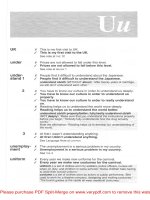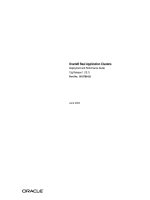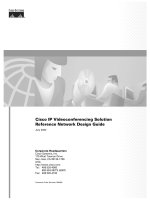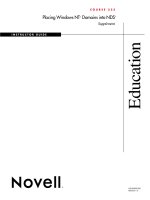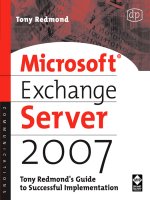Tài liệu Taking Control of Your Credit Teacher’s Guide docx
Bạn đang xem bản rút gọn của tài liệu. Xem và tải ngay bản đầy đủ của tài liệu tại đây (955.83 KB, 91 trang )
Taking
Control
of Your
Credit
Teacher’s
Guide
By Grant C. Black
Center for Economic Education
Indiana University-South Bend
Lesson Plan
Organization
The lessons in this Teacher’s Guide provide teachers with all the information necessary to
effectively teach the concepts presented in and related to the PBS39 Video Field Trip, Taking
Control of Your Credit. Each lesson clearly outlines every category of instructional elements
to help teachers quickly assess the purpose and strategy of the lesson.
Video Field Trip Connection
This section identies the chapter marker(s) on the Taking Control of Your Credit DVD corre-
sponding to the concepts targeted for the lesson.
Key Concepts
This section lists the concepts introduced in the Taking Control of Your Credit Video Field Trip
DVD chapters identied in the Video Field Trip Connection section. Key concepts are num-
bered based on the lesson number and order of concepts. For example, Key Concept 1.2 is
the second concept in Lesson 1.
Additional Concepts
This section lists concepts not directly discussed in the Taking Control of Your Credit Video
Field Trip DVD but related to its content. The additional concepts are included to enhance the
coverage of the Taking Control of Your Credit Video Field Trip DVD. Additional concepts are
numbered based on the lesson number and order of concepts (including Key Concepts). For
example, Additional Concept 2.10 is the tenth concept in Lesson 2.
Content Standards and Performance Expectations
This section identies the Indiana content standards and performance expectations associ-
ated with the Key Concepts and Additional Concepts for each lesson. These standards and
expectations outline the specic learning goals for students who complete the lesson. The
standards are identied by the codes designated in the Indiana Academic Standards by the
Indiana Department of Education.
Vocabulary
This section lists relevant vocabulary terms associated with the Key Concepts and Additional
Concepts for each lesson. How the suggested instructional strategies teach the vocabulary
terms vary across lessons. Some lessons include explicit strategies while others recommend
the teacher’s own methods.
Overview
This section provides a brief description of the lesson’s objectives and procedures to give
teachers a concise summary of the purpose of each lesson.
Procedures
This section outlines the suggested procedures to teach the concepts associated with each
lesson. Background information, teaching strategies, and assignments and activities are de-
scribed as applicable. Any document identied in the procedures in bold text is included at the
end of each lesson.
Assessment
This section describes suggested methods to assess student learning of the concepts associ-
ated with each lesson. Because students learn differently, using a variety of assessment tools
is encouraged.
Additional Resources
This section lists additional resources, including internet sources, which provide useful infor-
mation to supplement the lesson.
Content Standards and
Performance Expectations
The resources in this Teacher’s Guide are designed to correspond to the Indiana content
standards and performance expectations. Each lesson lists the specic standards associated
with its topics. To help with overall lesson planning, the following content standards and per-
formance expectations are related to the resources in this Teacher’s Guide:
Personal Finance
PF 1.1.5 Create and analyze a personal balance sheet
PF 1.1.7 Develop nancial goals for the future and a nancial plan based on one’s lifestyle,
expectations skills, and career choices
PF 1.1.10 Identify various traditional and technology resources available for obtaining
nancial information
PF 1.2.5 Distinguish between simple and compound interest
PF 3.3.1 Develop and modify a personal budget for income, saving, and xed, variable and
discretionary expenses
PF 3.3.2 Compare and contrast disposable and discretionary income
PF 3.3.3 Discuss the importance of the concept of “paying yourself rst” in relationship to
saving for meeting one’s nancial goals
PF 3.3.5 Analyze alternative actions for dealing with nancial difculties, such as credit
overextension, loss of job, and disability
PF 3.6.3 Evaluate the advantages and disadvantages of electronic banking such as direct
deposit, debit cards, ATM, and online banking
PF 3.6.4 Analyze privacy and security issues associated with nancial transactions,
endorsements and electronic banking
PF 4.1.2 Analyze impulse purchasing and how marketers employ techniques to stimulate
impulse buying
PF 4.1.4 Investigate goods and services, buying options, and present sound nancial
recommendations
PF 4.1.5 Compare and contrast the advantages and disadvantages of purchasing and
using credit
PF 4.3.1 Analyze sources and types of credit
PF 4.3.2 Analyze credit components such as principal, interest, payment periods, grace
periods, credit limits, incentive buying, fees, and minimum payments
PF 4.3.3 Analyze credit marketing techniques, features and pitfalls
PF 4.3.4 Create a plan for repaying debt
PF 4.3.5 Select an appropriate form of credit for a particular buying decision
PF 4.3.7 Explain the impact of credit reporting, the 5C’s of credit scoring, and FICO
scoring on consumer’s credit worthiness
PF 4.3.8 Evaluate the current laws involving consumer rights and responsibilities
PF 4.5.1 Evaluate the effects of living beyond one’s means
PF 4.5.2 Analyze the various alternatives to resolving credit problems
PF 4.5.4 Explain identity theft and its potential impact
PF 5.1.1 Use clear and legible handwriting in all written work and communication
PF 5.1.2 Demonstrate active listening skills
PF 5.1.3 Use discussion skills to assume leadership and participant roles
PF 5.1.4 Use research, composition, and oral skills to present information for a variety
of situations utilizing appropriate technology
PF 5.1.5 Work cooperatively with peers and authority gures
PF 5.1.6 Use clear and concise writing skills to describe, explain, and inform various
audiences
PF 5.1.7 Follow and interpret directions, graphs, charts and diagrams found in
technical writing
PF 5.1.8 Use appropriate industry terminology
Economics
E.1.2 Explain how consumers and producers confront the condition of scarcity, by
making choices which involve opportunity costs and tradeoffs
E.1.4 Describe how people respond predictably to positive and negative incentives
E.1.5 Predict how interest rates will act as an incentive for savers and borrowers
E.1.11 Formulate a savings or nancial investment plan for a future goal
E.6.1 Explain the basic functions of money
E.6.5 Compare and contrast credit, savings, and investment services available to the
consumer from nancial institutions
E.6.8 Formulate a credit plan for purchasing a major item comparing different
interest rates
Consumer Economics
CE.1.1 Demonstrate components of critical thinking, creative thinking, and reasoning
CE.1.4 Apply management, decision-making, and problem solving processes to
accomplish tasks and fulll responsibilities
CE.2.4 Examine interrelationships of standards, wants, needs, goals, and consumer
satisfaction
Pre-Test and Post-Test
To assess students’ overall level of learning from the Video Field Trip, Taking Control of Your
Credit, it is recommended to administer pre- and post-tests to students. Results from the pre-
test can also guide the teaching strategies and concepts to emphasize based on the lessons
included in this Teacher’s Guide.
Prior to watching the Taking Control of Your Credit Video Field Trip DVD or introducing any
related concepts, have students complete the following pre-test. The pre-test includes ten
true/false and multiple-choice questions. The pre-test and pre-test answer key are included.
For immediate feedback in the classroom, have students exchange their test with another
student after everyone has completed the pre-test. Review the answers to each question of
the pre-test and have the students grade one another’s tests. Have students return the pre-
tests so each student can review their understanding. Collect the pre-tests to assess students’
understanding of the main concepts.
After watching the Taking Control of Your Credit Video Field Trip DVD and completing the
accompanying lessons in this Teacher’s Guide, have students take the following post-test.
The post-test is identical to the pre-test, with ten true/false and multiple-choice questions. The
post-test and post-test answer key is included.
As with the pre-test, have students exchange their test with another student after everyone
has completed the post-test. Review the answers to each question of the post-test and have
the students grade one another’s tests. Have students return the post-tests so each student
can review their understanding. Collect the post-tests to assess students’ understanding of the
main concepts taught using the Taking Control of Your Credit Video Field Trip DVD.
The included pre-test, post-test, and answer keys serve only as templates and can be modi-
ed by teachers to tailor the material to their teaching strategies.
Pre-Test
Name:
What Do You Know about Credit?
For questions 1-5, indicate whether the given statement is true or false.
1. A credit card is the same as a debit card.
TRUE / FALSE
2. From the borrower’s perspective, an interest rate is the cost of borrowing money,
usually determined as a percentage of the amount borrowed.
TRUE / FALSE
3. Using a credit card to pay for consumable goods like food and beverages is a
good idea.
TRUE / FALSE
4. Some employers or schools may review a person’s credit report and deny
employment or acceptance to people with bad credit histories.
TRUE / FALSE
5. The grace period on a credit card is the time period between when you receive
your credit card bill and when you have to pay it.
TRUE / FALSE
For questions 6-10, choose the alternative that best answers the question.
6. To keep your credit card interest payments as low as possible,
a. pay the minimum monthly payment
b. try to pay off your credit card bill in full every month
c. pay off your credit card bill only after saving enough money to
pay it in full, no matter how long it takes
d. switch to a different credit card that has a higher interest rate
7. It is generally recommended that the proportion of your net income used for
credit payments not exceed:
a. 50%
b. 30%
c. 20%
d. 5%
8. According to a 2007 survey by the New Hampshire Higher Education
Assistance Foundation, the percentage of college freshmen who are at least
four months behind on their credit card payments is:
a. 7%
b. 21%
c. 38%
d. 70%
9. To help prevent the abuse of credit usage, a smart consumer will:
a. compare needs versus wants
b. usually only use credit to buy expensive, long-lasting goods
c. save money to plan for emergencies and future spending
d. all the above
10. Someone with signicant credit problems due to overusing credit cards
should contact the:
a. Better Business Bureau (BBB)
b. Internal Revenue Service (IRS)
c. Consumer Credit Counseling Service (CCCS)
d. Securities and Exchange Commission (SEC)
d. 5%
8. According to a 2007 survey by the New Hampshire Higher Education
Assistance Foundation, the percentage of college freshmen who are at least
four months behind on their credit card payments is:
a. 7%
b. 21%
c. 38%
d. 70%
Pre-Test Answer Key
What Do You Know about Credit?
1. A credit card is the same as a debit card.
FALSE
2. From the borrower’s perspective, an interest rate is the cost of borrowing money,
usually determined as a percentage of the amount borrowed.
TRUE
3. Using a credit card to pay for consumable goods like food and beverages is a
FALSE
4. Some employers or schools may review a person’s credit report and deny
employment or acceptance to people with bad credit histories.
TRUE
5. The grace period on a credit card is the time period between when you receive
your credit card bill and when you have to pay it.
FALSE
6. To keep your credit card interest payments as low as possible,
a. pay the minimum monthly payment
b. try to pay off your credit card bill in full every month
c. pay off your credit card bill only after saving enough money to pay it in
full, no matter how long it takes
d. switch to a different credit card that has a higher interest rate
7. It is generally recommended that the proportion of your net income used for
credit payments not exceed:
a. 50%
b. 30%
c. 20%
d. 5%
8. According to a 2007 survey by the New Hampshire Higher Education
Assistance Foundation, the percentage of college freshmen who are at least
four months behind on their credit card payments is:
a. 7%
b. 21%
c. 38%
d. 70%
9. To help prevent the abuse of credit usage, a smart consumer will:
a. compare needs versus wants
b. usually only use credit to buy expensive, long-lasting goods
c. save money to plan for emergencies and future spending
d. all the above
10. Someone with signicant credit problems due to overusing credit cards should
contact the:
a. Better Business Bureau (BBB)
b. Internal Revenue Service (IRS)
c. Consumer Credit Counseling Service (CCCS)
d. Securities and Exchange Commission (SEC)
Post-Test
Name:
What Do You Know about Credit?
For questions 1-5, indicate whether the given statement is true or false.
1. A credit card is the same as a debit card.
TRUE / FALSE
2. From the borrower’s perspective, an interest rate is the cost of borrowing money,
usually determined as a percentage of the amount borrowed.
TRUE / FALSE
3. Using a credit card to pay for consumable goods like food and beverages is a good
idea.
TRUE / FALSE
4. Some employers or schools may review a person’s credit report and deny employ-
ment or acceptance to people with bad credit histories.
TRUE / FALSE
5. The grace period on a credit card is the time period between when you receive your
credit card bill and when you have to pay it.
TRUE / FALSE
For questions 6-10, choose the alternative that best answers the question.
6. To keep your credit card interest payments as low as possible
a. pay the minimum monthly payment
b. try to pay off your credit card bill in full every month
c. pay off your credit card bill only after saving enough money to pay it in
full, no matter how long it takes
d. switch to a different credit card that has a higher interest rate
7. It is generally recommended that the proportion of your net income used for
credit payments not exceed
a. 50%
b. 30%
c. 20%
d. 5%
8. According to a 2007 survey by the New Hampshire Higher Education Assistance
Foundation, the percentage of college freshmen who are at least four months behind
on their credit card payments is:
a. 7%
b. 21%
c. 38%
d. 70%
9. To help prevent the abuse of credit usage, a smart consumer will
a. compare needs versus wants:
b. usually only use credit to buy expensive, long-lasting goods
c. save money to plan for emergencies and future spending
d. all the above
10. Someone with signicant credit problems due to overusing credit cards should
contact the:
a. Better Business Bureau (BBB)
b. Internal Revenue Service (IRS)
c. Consumer Credit Counseling Service (CCCS)
d. Securities and Exchange Commission (SEC)
Post-Test Answer Key
What Do You Know about Credit?
1. A credit card is the same as a debit card.
FALSE
2. From the borrower’s perspective, an interest rate is the cost of borrowing money,
usually determined as a percentage of the amount borrowed.
TRUE
3. Using a credit card to pay for consumable goods like food and beverages is a
good idea.
FALSE
4. Some employers or schools may review a person’s credit report and deny
employment or acceptance to people with bad credit histories.
TRUE
5. The grace period on a credit card is the time period between when you receive
your credit card bill and when you have to pay it.
FALSE
6. To keep your credit card interest payments as low as possible,
a. pay the minimum monthly payment
b. try to pay off your credit card bill in full every month
c. pay off your credit card bill only after saving enough money to pay it in
full, no matter how long it takes
d. switch to a different credit card that has a higher interest rate
7. It is generally recommended that the proportion of your net income used for
credit payments not exceed:
a. 50%
b. 30%
c. 20%
d. 5%
8. According to a 2007 survey by the New Hampshire Higher Education
Assistance Foundation, the percentage of college freshmen who are at least
four months behind on their credit card payments is:
a. 7%
b. 21%
c. 38%
d. 70%
9. To help prevent the abuse of credit usage, a smart consumer will:
a. compare needs versus wants
b. usually only use credit to buy expensive, long-lasting goods
c. save money to plan for emergencies and future spending
d. all the above
10. Someone with signicant credit problems due to overusing credit cards should
contact the
a. Better Business Bureau (BBB)
b. Internal Revenue Service (IRS)
c. Consumer Credit Counseling Service (CCCS)
d. Securities and Exchange Commission (SEC)
Lesson 1:
What is
Credit?
Video Field Trip Connection
Chapter 1
Chapter 2
Key Concepts
1.1 Debit versus credit
1.2 Types of credit
1.3 Credit cards
Additional Concepts
1.4 Ways individuals pay for goods and services
1.5 Types and functions of money
1.6 Charge card versus credit card
1.7 Checking accounts and savings accounts
Content Standards and Performance Expectations
PF 3.6.3
PF 4.1.4
PF 4.1.5
PF 4.3.1
PF 4.3.5
PF 5.1.1
PF 5.1.2
PF 5.1.3
PF 5.1.4
PF 5.1.6
PF 5.1.8
E.6.1
E.6.5
CE.1.1
Vocabulary
ATM card — card that allows withdrawals and deposits from bank accounts using an
automatic teller machine (ATM) and functions as a debit card requiring a personal iden-
tication number for transactions.
Borrower — a person or institution that obtains money from a lender with the
obligation to repay the money loaned.
Car loan — credit issued by a nancial institution for the express purpose of
purchasing a vehicle.
Charge card — card that allows purchase but the charged payment must be paid upon
receipt of the billing statement.
Check — written document that serves as money by drawing on deposits at a nancial
institution.
Checking account — account at a nancial institution that allows an individual to
deposit money into that account, which can be accessed on demand.
Credit — trust in a buyer’s ability and intention to pay in the future.
Credit card — card that acts as a means of exchange like money by authorizing
payment for goods and services based on the buyer’s ability and intention to repay the
lender.
Debit — a payment charged to an individual or institution.
Debit card — card that allows purchases by directly deducting the payment from the
buyer’s personal bank account, typically a checking account.
Lender — a person or institution that grants access to money conditioned on the
loaned money being returned with interest for its temporary use.
Loan — credit agreement between a lender and borrower.
Mortgage — a lien upon real estate given to secure credit.
Revolving credit — credit automatically renewed as credit payments are made.
Savings account — account at a nancial institution that allows an individual to
deposit money into that account, which may or may not be accessed on demand and
is typically used as a means of holding money reserves.
SMART card — card that has a micro processing chip embedded with relevant data
that allows the user to perform specic actions, such as purchasing goods and
services like a credit card.
Student loan — credit issued by the government or a nancial institution for the
express purpose of purchasing education services.
Overview
In the Taking Control of Your Credit Video Field Trip DVD, Julian and her friend learn
what credit is and why it is used, as well as about different types of credit. This lesson
informs students about credit and its use by examining different methods of payment
and types of credit. Students are engaged by exploring personal spending patterns
and credit usage. The lesson strengthens student’s communication and critical thinking
skills through classroom activities and personal exercises.
Procedures
1. Watch the Taking Control of Your Credit Video Field Trip DVD (at least
chapters 1 and 2).
2. Ask students for their reactions to the DVD. Encourage any responses without
trying to initially steer the direction of the discussion.
3. Introduce information about teen spending and credit card use using the Facts about
Teen Spending sheet. Highlight the substantial spending by teens, the alarming misuse
of credit cards by college students, and the widespread use of credit cards among the
entire population.
4. Review the vocabulary as appropriate to ensure students clearly understand the
concepts being discussed.
5. As an in-class exercise to engage students at a personal level, use Activity 1 Class-
room Survey to examine students’ sources of income, spending, use of checking and
savings accounts, and use of credit. Expand on the survey questions to stimulate stu-
dents’ personal reection about these issues.
6. Distribute Exercise 1 Family Credit Survey to students. Explain that this exercise asks
students to investigate how goods found at home are purchased, the usage of credit by
the family, and the types of credit used. After completing the survey with their parents,
students must write a short assessment of their family’s credit usage.
7. Lesson 2 explores where to get credit, as well as credit card marketing.
Assessment
Teacher observation of classroom participation
Rubric for Exercise 1
Additional Resources
/> “Clothed, Fed and Over Their Heads?”
New Hampshire Higher Education Assistance Foundation
( /> “Credit for Beginners,” a lesson from the
National Council on Economic Education
( />
/> /> “Targeting Teens,” Newspaper Association of America, August 2007
( /> Consumers-2007.aspx
)
Teacher’s Guide:
How Interest Can Work For You and How Interest Can Work Against You!,
Harlan Day, Indiana Council for Economic Education, 2008
Facts about Teen Spending
Trends in Teen Spending
1
• $179 billion: amount spent by teens aged 12-17 on goods and services in 2006
• $107: average amount of money that teens spend per week
• 29%: percent of teens spending more than $100 per week
• 60%: percent of teens that receive money from their parents as a source of income
• 45%: percent of teens earning money from odd jobs or part-time jobs
• 56%: percent of teens having a savings account
• 10%: percent of teens having a checking account
• 7%: percent of teens having access to a parent’s credit card
• 18%: percent of teens wanting to get a credit card in their own name
• 33%: percent of older teens aged 18-19 having a credit card in their own name
• 200,000: number of bankruptcy cases led by young adults aged 18-25 in 2006
2
• 60%: percent of students saying they never had a meaningful conservation
about personal nances with their parents
2
Credit Card Use among College Students in 2007
3
• $3,106: average credit card debt
• $7,937: average credit limit
• 5.96: average number of credit cards
• 1.98: average number of credit cards actively in use at the time of the survey
• 42%: percent with six or more credit cards
• $1,200: average credit card debt for students with two credit cards
• $4,830: average credit card debt for students with six or more credit cards
• 28%: percent of freshmen with more than $3,000 in credit card debt
• 51%: percent of freshmen delinquent on their credit card payments
• Up to 10%: percentage of college students who will drop out due to
credit card problems
2
Credit Card Use among the US population
• $3,238: average credit card debt
4
• 4: average number of credit cards
5
• 14%: percent of persons with more than 10 credit cards
5
Sources:
1 — ”Targeting Teens,” Teenage Research Unlimited, 2007
2 —”Can You Believe This?” CARE Program
( />0Believe%20This%20Handout%20new%20logo.pdf)
3 — ”Clothed, Fed and Over Their Heads,” New Hampshire Higher Education
Assistance Foundation, 2008
4 — Federal Reserve, Consumer Credit, March 7, 2008 release
5 — /> 1In7AmericansCarries10CreditCards.aspx?page: all
Activity 1
Classroom Survey
Survey students in your classroom about their usage of checking accounts, savings
accounts, and credit. Compile the numerical results for each question on the board and
discuss the ndings with the students.
1. How many students work an odd job or part-time job to earn some income?
Count Percent of Class
(Count/Number of Students)x100
2. How many students receive an allowance or other money from parents?
Count Percent of Class
3. How many students spend at least $20 per week to buy various goods and
services?
Count Percent of Class
4. Who has their own checking account?
Count Percent of Class
5. Who has their own savings account?
Count Percent of Class
6. Who uses an ATM or debit card, either their own or their parents?
Count Percent of Class
7. Who has their own credit card?
Count Percent of Class
8. Who uses a credit card, either their own or their parents?
Count Percent of Class
9. Who has borrowed money through any type of loan to buy something?
Count Percent of Class
Exercise 1
Family Credit Survey
Ask your parents the following questions about how they purchased goods at your
home and the types of credit they have used. Record their answers in the space
provided.
1. How many credit cards does the family have, including gas and store credit cards?
2. How often are credit cards usually used to buy things?
Never
Monthly
Weekly
Daily
Other (Explain: )
3. List all the types of loans the family has ever had (mortgage, car loan,
student loan, etc.)
4. Check the appropriate box in the table below to indicate how common items at a
home are purchased. Note that some answers can be a combination of credit and
other methods. If you do not have a listed item at your home, skip to the next item.
5. If applicable, ask your parents why they chose to use credit to buy some of the
items listed above.
Based on your own opinion, write a paragraph assessing your family’s use of credit to
make purchases, including the various types of credit used.
Rubric for Exercise 1
Name
Performance Indicator
0 1 2 3 4
Student demonstrated understanding of ways to
purchase goods and services, including differences
between debit and credit
Student demonstrated understanding of different
types of credit and their sources
Student effectively used critical thinking skills to
analyze the use of credit and their family
Student appropriately used technical terminology
Student used clear and concise writing skills
Point Total
Point Total from above: (20 Possible Points)
Grade:
Grading Scale:
A = 18 – 20 points
B = 16 – 17 points
C = 14 – 15 points
D = 11 – 13 points
F = 0 – 10 points
Lesson 2:
Finding
Credit
Video Field Trip Connection
Chapter 1
Chapter 2
Chapter 6
Key Concepts
2.1 Access to credit
2.2 Institutions offering credit
2.3 Credit card marketing techniques
2.4 Choosing a credit card
Additional Concepts
2.5 Types of nancial institutions
2.6 Marketing
2.7 Inuence of incentives and disincentives on consumer behavior
2.8 Impulse buying
2.9 Cost-benet analysis
2.10 Resources for obtaining nancial information
Content Standards and Performance Expectations
PF 1.1.10
PF 4.1.2
PF 4.3.1
PF 4.3.2
PF 4.3.3
PF 5.1.1
PF 5.1.2
PF 5.1.3
PF 5.1.4
PF 5.1.5
PF 5.1.6
PF 5.1.8
E.1.2
E.1.4
E.6.5
CE.1.1
CE.1.4

